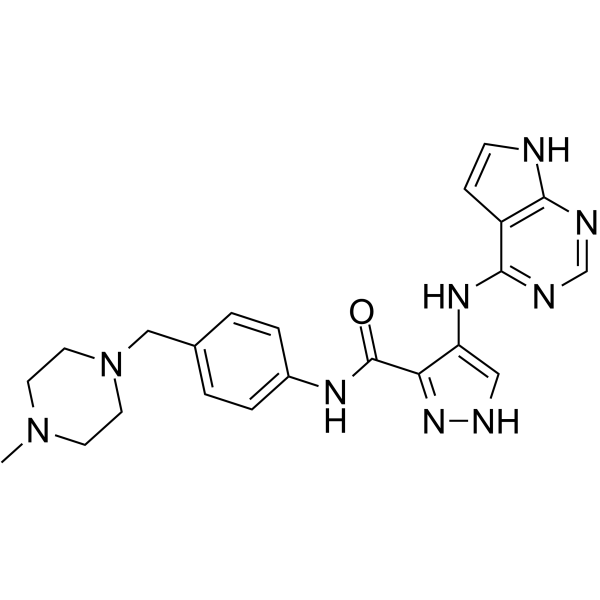上海金畔生物科技有限公司为生命科学和医药研发人员提供生物活性分子抑制剂、激动剂、特异性抑制剂、化合物库、重组蛋白,专注于信号通路和疾病研究领域。
FN-1501 纯度: 99.71%
FN-1501 是一种有效的 FLT3 和 CDK 抑制剂,对 CDK2/cyclin A,CDK4/cyclin D1,CDK6/cyclin D1 和 FLT3 的 IC50 值分别为 2.47,0.85,1.96, 和 0.28 nM。FN-1501 具有抗肿瘤的活性。

FN-1501 Chemical Structure
CAS No. : 1429515-59-2
| 规格 | 价格 | 是否有货 | 数量 |
|---|---|---|---|
| Free Sample (0.1-0.5 mg) | Apply now | ||
| 10 mM * 1 mL in DMSO | ¥2750 | In-stock | |
| 5 mg | ¥2500 | In-stock | |
| 10 mg | ¥4500 | In-stock | |
| 50 mg | ¥14000 | In-stock | |
| 100 mg | ¥21000 | In-stock | |
| 200 mg | 询价 | ||
| 500 mg | 询价 |
* Please select Quantity before adding items.
FN-1501 相关产品
•相关化合物库:
- Clinical Compound Library Plus
- Bioactive Compound Library Plus
- Cell Cycle/DNA Damage Compound Library
- Kinase Inhibitor Library
- Protein Tyrosine Kinase Compound Library
- Anti-Cancer Compound Library
- Clinical Compound Library
- Anti-Aging Compound Library
- Anti-Breast Cancer Compound Library
- Anti-Pancreatic Cancer Compound Library
- Anti-Blood Cancer Compound Library
| 生物活性 |
FN-1501 is a potent inhibitor of FLT3 and CDK, with IC50s of 2.47, 0.85, 1.96, and 0.28 nM for CDK2/cyclin A, CDK4/cyclin D1, CDK6/cyclin D1 and FLT3, respectively. FN-1501 has anticancer activity. |
||||||||||||||||
|---|---|---|---|---|---|---|---|---|---|---|---|---|---|---|---|---|---|
| IC50 & Target |
|
||||||||||||||||
| 体外研究 (In Vitro) |
FN-1501 is a potent inhibitor of FLT3 and CDK, with IC50s of 2.47 ± 0.21, 0.85 ± 0.28, 1.96 ± 0.08 and 0.28 ± 0.01 nM for CDK2/cyclin A, CDK4/cyclin D1, CDK6/cyclin D1 and FLT3, respectively. FN-1501 shows potent inhibitory activity against several tumor cells, such as MGC803, RS4;11, MCF-7, HCT-116, and NCI-H82, with GI50s of 0.37 ± 0.04, 0.05 ± 0.01, 2.84 ± 0.25, 0.09 ± 0.04, 0.11 ± 0.02 nM, respectively[1]. 上海金畔生物科技有限公司 has not independently confirmed the accuracy of these methods. They are for reference only. |
||||||||||||||||
| 体内研究 (In Vivo) |
FN-1501 exhibits potent antitumor activity, and shows little cytotoxicity on normal lymphocyte cells, with LD50 of 185.67 mg/kg in ICR mice. FN-1501 (15. 30, or 40 mg/kg/d, i.v.) dose-dependently and significantly suppresses the growth of tumor in MV4-11-cell-inoculated-xenograft mice[1]. 上海金畔生物科技有限公司 has not independently confirmed the accuracy of these methods. They are for reference only. |
||||||||||||||||
| Clinical Trial |
|
||||||||||||||||
| 分子量 |
431.49 |
||||||||||||||||
| Formula |
C22H25N9O |
||||||||||||||||
| CAS 号 |
1429515-59-2 |
||||||||||||||||
| 运输条件 |
Room temperature in continental US; may vary elsewhere. |
||||||||||||||||
| 储存方式 |
|
||||||||||||||||
| 溶解性数据 |
In Vitro:
DMSO : ≥ 50 mg/mL (115.88 mM) * “≥” means soluble, but saturation unknown. 配制储备液
*
请根据产品在不同溶剂中的溶解度选择合适的溶剂配制储备液;一旦配成溶液,请分装保存,避免反复冻融造成的产品失效。 In Vivo:
请根据您的实验动物和给药方式选择适当的溶解方案。以下溶解方案都请先按照 In Vitro 方式配制澄清的储备液,再依次添加助溶剂: ——为保证实验结果的可靠性,澄清的储备液可以根据储存条件,适当保存;体内实验的工作液,建议您现用现配,当天使用; 以下溶剂前显示的百
|
||||||||||||||||
| 参考文献 |
|
| Kinase Assay [1] |
The activity of the CDKs and FLT3 are assayed in reaction buffer (20 mM HEPES pH 7.5, 10 mM MgCl2, 1 mM EGTA, 0.02% Brij35, 0.02 mg/mL BSA, 0.1 mM Na3VO4, 2 mM DTT, 1% DMSO) at room temperature at a final ATP concentration of 10 mM. Then FLT3, dissolved in 100% DMSO at the indicated doses, are delivered into the kinase reaction mixture by acoustic technology and incubated for 20 min at room temperature. After 10 μM [γ-33P] ATP (specific activity 10 Ci/μL) is added to initiate the reaction, the reactions are carried out at 25°C for 120 min. The kinase activities are detected by the filterbinding method. IC50 values and curve fits are obtained by Prism[1]. 上海金畔生物科技有限公司 has not independently confirmed the accuracy of these methods. They are for reference only. |
|---|---|
| Cell Assay [1] |
The human AML cell line MV4-11 is cultured in IMDM media with 10% FBS and supplemented with 2% l-glutamine and 1% penicillin/streptomycin. The MV4-11 cell line is maintained in culture media at 37°C with 5% CO2. The effects of FN-1501 on MV4-11 proliferation are performed. Cells are cultured in 96-well culture plates (10 000 cells/well). FN-1501 at various concentrations is added to the plates. Cell proliferation is determined after treatment with FN-1501 for 72 h. Cell viability is measured using the CellTiter-Glo assay, and luminescence is measured in a multilabel reader. Data are normalized to control groups (DMSO) and represented as the means of three independent measurements with standard errors of <20%. IC50 values are calculated using Prism 5.0[1]. 上海金畔生物科技有限公司 has not independently confirmed the accuracy of these methods. They are for reference only. |
| Animal Administration [1] |
Mice[1] 上海金畔生物科技有限公司 has not independently confirmed the accuracy of these methods. They are for reference only. |
| 参考文献 |
|
所有产品仅用作科学研究或药证申报,我们不为任何个人用途提供产品和服务
